As strength training becomes more popular, more and more sports are starting to adopt strength training as part of the normal training routine. Sports that have typically shunned strength training are now using it to gain a competitive advantage.
Strength training involves performing exercises that improve force production capabilities. It can be performed with various implements and at various speeds in order to maximize force generation for sport.
However, strength training can be a very broad term. Doing 100 push-ups would be considered strength training. But so would bench pressing the heaviest weight possible for one rep.
Both of these examples have a completely different set of adaptations. So in order to adequately prescribe strength training, we need to know what kind of strength training to perform for what outcome we want.
What Is Strength?
Strength is simply a measure of force production [1]. It can be measured in various ways. From the maximum amount of weight lifted in a given exercise or the amount of force produced in a given exercise using a force plate. It can even be measured as how quickly force can be produced.

How to Dominate Every Fight with Raw, Explosive Power No One Can Match
Discover the underground blueprint that has quietly turned MMA hopefuls into legends, using nothing but sheer, brute force and bulletproof conditioning techniques.
Strength can also be measured during each type of contraction. Concentric (upwards phase), Eccentric (downwards phase), and Isometric (force produced with zero movement). You can produce more force eccentrically than isometrically, and more force isometrically then concentrically.
If strength has so many variables, how do you know which is relevant to martial arts? Well, like most sports that require a combination of physical qualities (strength, power, speed, endurance, etc), all measures of strength are relevant to martial arts.
Martial artists need to be able to express their strength at very fast speeds, or to be able to express force production against an opponent with speed, or have the capacity to produce a large amount of force when grappling in order to manipulate an opponent.
Training one type of strength isn’t an isolated adaptation. Rather, certain strength qualities will influence others or provide the opposite adaptations to some.
What Are The Different Tools For Strength Training?
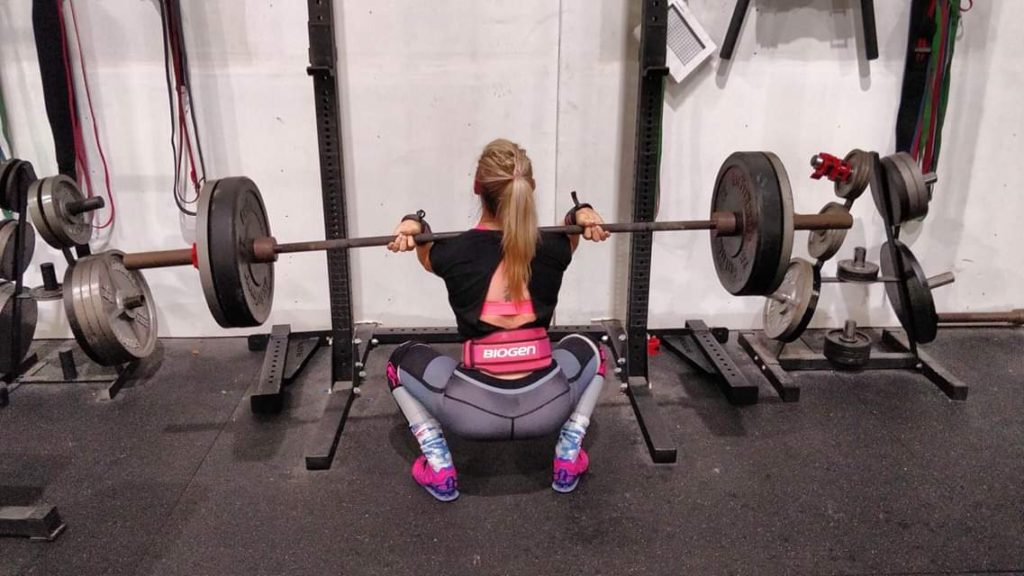
Strength training can be performed with a variety of different pieces of equipment. Take this list for example:
- Medicine Balls
- Bodyweight & Suspension Trainers
- Kettlebells
- Dumbbells
- Barbells
- Machines
- Sandbags
- Grip Implements
- Odd Objects such as Stones, Logs, Sleds, Tires
With so many different options, you may be wondering what the best tool is for strength training for martial arts…
There is no best tool.
It is all about what you use for what purpose in your training.
For example, if you’re performing explosive throws, you may choose a medicine ball or a kettlebell. Other strength training tools aren’t built for this purpose.
However, if you are lifting maximally, then the barbell would be the appropriate choice. Dumbbells wouldn’t be able to be loaded heavy enough or provide the stability to truly lift maximally. This is because you will engage more stabilizer muscles compared to the increased stability from using a barbell. You will also be limited by what you have available in your gym to train with.
What Are The Different Types Of Strength Training
Strength isn’t just about how much weight you can lift. Strength training can be broken down into many different strength qualities. Some qualities make great use of the stretch-shortening cycle (SSC) while others don’t.
The SSC involves a pre-stretch of the muscle fibers (eccentric contraction) which are then immediately shortened (concentric contraction). The force generated during the concentric phase when a pre-stretch occurs is much greater than when there is no pre-stretch [2]. Essentially, it acts as a spring-like mechanism. The harder or faster the spring is pushed down, the higher the spring will jump.
It may seem like every movement should then utilize the SSC in order to produce more force. However, not all movements require a pre-stretch or have time for it. Hence, there are many different ways to display strength qualities.
Reactive Strength
Reactive strength is the ability to utilize the fast SSC. By fast, I mean <250ms of time spent on the ground. Think sprinting at maximum velocity. Or skipping drills you may perform in your warm-ups.
Reactive strength also applies to the upper body where throwing fast combinations of punches or kicks requires reactive strength of the arms, trunk, or leg on the floor when repeatedly kicking.
Within strength training, reactive strength takes the form of drop jumps, hurdle bounds, and various ankle pops.
Recent research has actually called for reactive strength to no longer be labeled as a strength quality [6]. Rather, reactive strength should be classed as a skill which is influenced by maximal and eccentric strength.
This means, the skill of stiffness and reactive ability shouldn't only be trained through the exercises mentioned above, but through task specific conditions such as dropping off of a box to overload the reactive component of a punch.
Explosive or Speed Strength
Explosive strength also goes by speed strength. It is the ability to utilise the SSC but at a slower rate (>250ms). For example, a vertical jump.
This can be identified as the ability to produce power. Power is the combination of force x velocity where the more force you can produce at a fast speed means more power is generated.
In martial arts, this could be when jumping for a flying knee or shooting for some takedowns.
Within strength training, explosive strength takes the form of different jumping and throwing variations.
Starting Strength
Starting strength is similar to explosive strength in the fact that both require explosive force. However, starting strength is characterized by the lack of SSC involvement. That means the movement is purely concentric or isometric.
It represents the ability to rapidly produce this force without the pre-stretch. This is often used in grappling exchanges you need to manipulate your opponent.
Strength Speed
Strength speed seems like just another way of saying speed strength. But the distinction is the first word used. Strength speed is about moving heavier objects with speed. Olympic Weightlifting is a good example of this as heavy loads are moved quickly.
In martial arts, strength speed is very important when it comes to manipulating opponents in grappling exchanges similar to starting strength.
Maximal Strength
Maximal strength is defined as the most amount of force you can produce regardless of time. It is often measured using a one-repetition maximum as it requires little extra equipment other than your normal gym equipment.
While moving heavy external loads during martial arts isn’t part of the sport (unless you’re competing in open class in a grappling tournament), improving maximal strength creates a strength reserve where low-level force activities become easier due to being a smaller percentage of the maximal force that can be produced.
Strength Endurance
Strength endurance becomes more important in the grappling arts. The ability to maintain a high level of grip strength and upper body tension are two of the many keys to grappling success. Strength endurance is highly influenced by maximal strength and the aerobic and anaerobic energy systems.
Strength Training Adaptations
Maximal Strength Training | High-Velocity Strength Training |
|---|---|
Increases in load-specific coordination (i.e. technical aspect of lifting a heavy load) | Increased velocity-specific coordination. |
Increases in muscle fiber size | Increase in muscle fiber contractile velocity |
Shifting of type IIX to type IIA muscle fiber (increasing the oxidative capacity of the fast twitch muscle fiber) | Greater proportion of type IIX muscle fiber |
Increases in co-contraction (greater activation of opposing muscle groups creating slower contraction velocities) | Decreased co-contraction |
Increases in prime mover activation throughout the whole range of movement | Greater rate of force development (RFD) |
Increase in tendon stiffness | Cell |
If you have a sharp eye, you may notice that maximal strength training produces opposite adaptations to high-velocity strength training. This is the art and science of properly programmed strength training for martial arts and sport.
If we categorize the types of strength into the above table, maximal strength would fit into the maximal strength column and the rest would fit under the high-velocity strength training column.
If too much time is spent on either side, performance won’t be optimized.
Let’s talk about some of the adaptations listed in the table above.
Most of the adaptations from maximal strength training would seem to have a negative effect on martial arts performance. Seeing increases in muscle fiber size isn’t often an adaptation that is wanted as there are weight classes. Putting on extra weight means having to lose that extra weight come competition time.
Increases in co-contractions can be a useful adaptation to protect the joints. However, it slows down the contraction velocity (hence why if you throw a punch with your arm muscles tensed, the punch will be slow).
The same goes for having a muscle activated throughout the whole movement. Martial artists are able to strike with so much force at fast speeds because their muscles ARE NOT activated throughout the whole movement. Instead, they take advantage of what is known as double peak muscle activation.
Some adaptations from maximal strength training provide positive adaptations for martial arts such as increases in tendon stiffness which improves the efficiency of using elastic energy from the SSC.
However, the adaptations gained from high-velocity strength training are likely more beneficial to martial artists than the adaptations from maximal strength training. But, there are a few reasons why maximal strength training should make an appearance in a martial artist training program.
- Improving maximal strength raises the ceiling. Meaning, if you can only produce a small amount of force, then it doesn’t matter how quickly you can produce it. However, if you can produce a lot of force, then you have a greater potential to produce a lot of force quickly. This is known as having a strength reserve.
- Maximal strength influences all other strength qualities. Similar to above, it’s difficult to be explosive if you are very weak.
- The shifting in Type IIX muscle fiber to a slower version of fast-twitch muscle fiber is actually a positive adaptation in martial arts where there is a large endurance component. Type IIX muscle fibers fatigue very quickly.
- Maximal strength training desensitizes inhibitory force feedback mechanisms within the muscle and tendon. Meaning, the less this protective mechanism comes into play, the more force that is likely to be produced by the muscle.
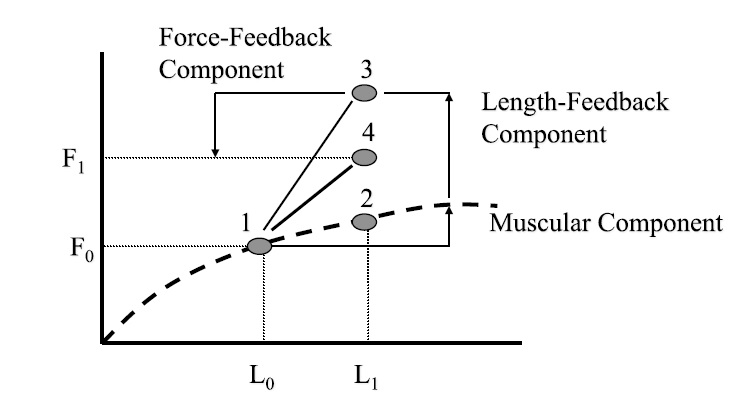
As shown in the graph above, for a given length change within the muscle, we get force production from circle 1 to 2. However, with the contribution of the excitatory length-feedback component, the amount of force increases dramatically to circle 3. This excitatory mechanism increases force production from within the muscle by minimising the stretch and maximising activation.
However, the inhibitory force-feedback component reduces agonist force output as a protective mechanism back down to circle 4. In theory, if you can enhance the excitatory mechanism and desensitise the inhibitory mechanism, then greater force production is possible. How can this be done?
By combining BOTH maximal strength training and high-velocity strength training (specifically plyometric and other ballistic actions).
How Can Strength Training Be Specific To Martial Arts?
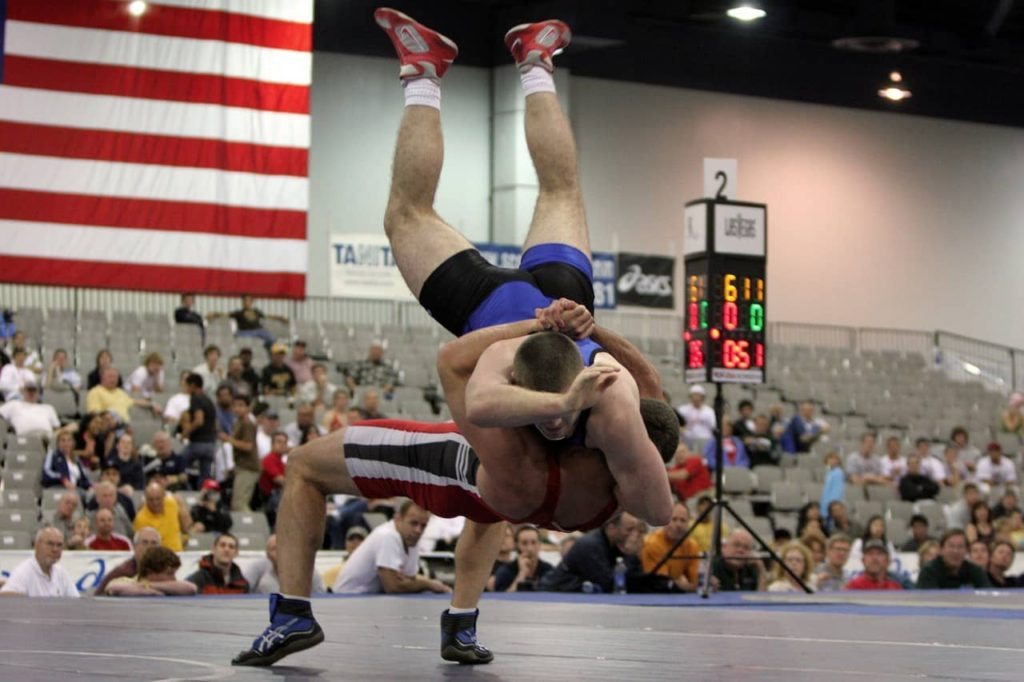
When strength training is applied to sports outside of traditional strength sports (powerlifting, bodybuilding, weightlifting, and strongman), the methods and planning is often derived from these strength sports.
For example, some martial artists may plan their strength training by muscle group (bodybuilding influence) or by the big three lifts (powerlifting influence).
While strength sport methods have their place in martial arts and other sports, they can’t be copied and pasted to the martial artist. The physical needs of martial arts are much different from a pure strength sport.
Remember in the previous section I mentioned that performing only maximal or high-velocity strength training won’t optimize performance? Taking programs from strength sports because they are strong is exactly that… performing only maximal strength and strength speed if Olympic Weightlifting is used.
So what needs to be done to make strength specific to martial arts?
‘Functional’ Strength Training
The term functional needs to be removed from the strength training vernacular. It’s a great buzzword that is used by personal trainers to entice clientele who don’t want to get ‘big and bulky’ and instead, train movements ‘related to everyday life.’
If you were to put a picture on a poster to represent functional training, it’d be someone squatting on a Bosu ball while performing bicep curls. The term functional training is often used to label any exercise on an unstable surface.
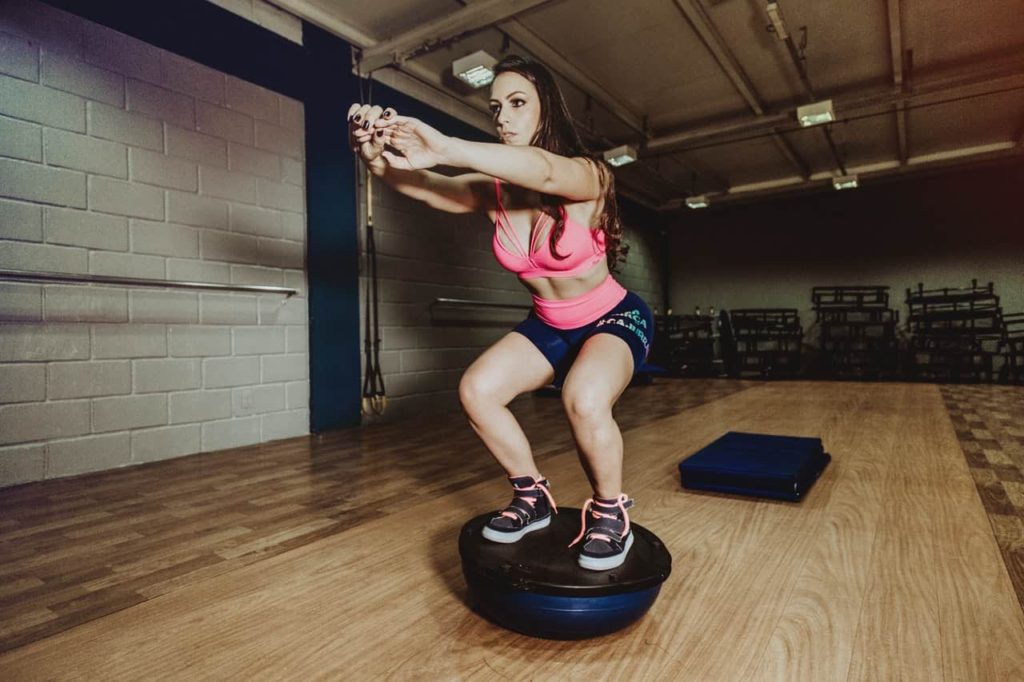
Functional training isn’t used as much anymore in strength training for sport. It has been replaced with ‘sport-specific’ training. Sport-specific training can actually be a good thing if done correctly. But sadly, sport-specific and functional training are painted with the same brush in most training programs.
So what is functional or sport-specific strength training really (I’m going to refer to it as sport-specific from here on)? Sport-specific can mean two different things.
1. Athlete specific – If the exercises help the athlete improve, feel better, or address some weakness that allows them to perform better in their martial art, then it is athlete specific. And therefore, it is also sport-specific no matter how far removed from the sport it is.
2. Sport-specific – The exercises directly transfer to the sporting movements. This will be covered in-depth further down.
Sport-specific shouldn’t get confused with mimicking movements from the sport. Just because it looks like the sport, doesn’t mean it’s doing anything to make the athlete better for the martial art.
For example, shadow boxing with dumbbells is ‘sport-specific’ as it directly mimics the punch. But it's not a great tool if you want to learn to punch harder and faster. Gravity only works vertically.
Here are some theories that can actually make strength training specific to the sport or martial art.
Dynamic Correspondence
Dynamic correspondence was first created and used by Dr. Verkhoshanksy. You may be familiar with the name if you’re into the older Soviet training texts.
It refers to increasing the working effect (more on the working effect further down in the article) of movements that are closely related to competitive movements. These exercises are seen to directly transfer to sporting performance.
Dynamic correspondence has these five criteria an exercise has to meet to be considered [3]:
- The muscle groups involved in the exercise – must be the same as the competition exercise.
- The amplitude/direction of the movement – range of motion and direction of movement should be the same as the competition exercise.
- The accentuated region of force production – shares similar regions with the competition exercise where the greatest forces are produced within the range of motion.
- The magnitude of force-effort and time of its application – the amount of force and the time to produce it is similar to the competition exercise.
- The regime of muscular contraction – the exercise replicates the same muscular contraction as the competition exercise.
Applying these criteria to martial arts, an exercise with high dynamic correspondence to punching may be the single-arm medicine ball punch from a fight stance. Improving the force and velocity generated during this exercise is likely to transfer to a harder punch.
Utilizing exercises that match dynamic correspondence is best used with higher-level athletes and martial artists.
Transfer of Training
The transfer of training is a pyramid of specificity created by Dr. Bondarchuk, a Soviet hammer thrower and coach. This pyramid classifies exercises based on how closely they relate to the competitive exercise. It is split into four parts [4].
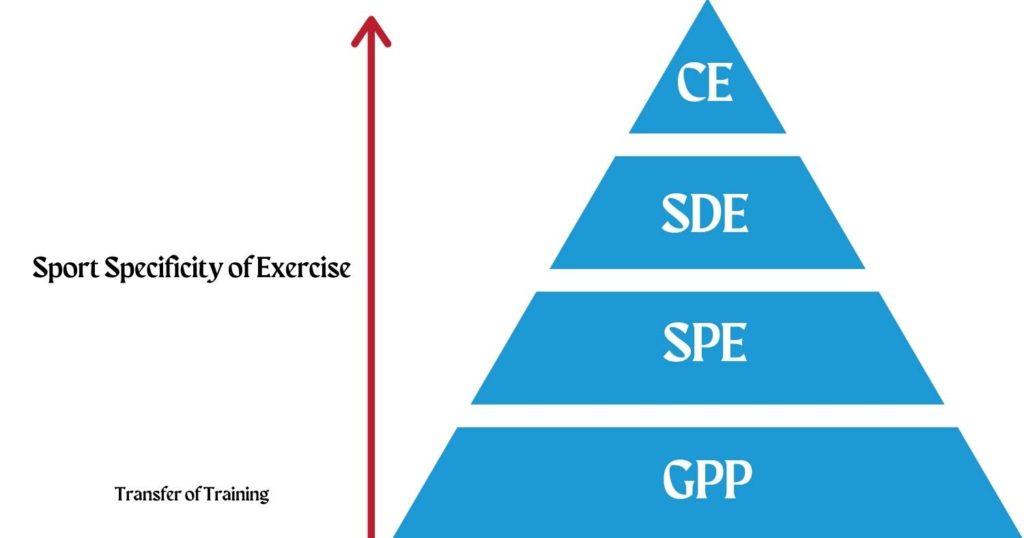
At the top of the pyramid are competition exercises (CE). These are the movements that make up the sport itself. For martial artists, that would be striking or grappling during a live sparring session.
For throwers, it might be the javelin or hammer. This is at the top of the pyramid because the number of exercises that can be selected is limited.
Below are the special developmental exercises (SDE). This part of the pyramid is slightly wider to represent the wider range of exercises that can be classified as SDE.
These exercises use the same muscles with similar movements as the competition exercises. These exercises would fit most of the dynamic correspondence criteria making them specific to the competitive exercise.
These exercises will be splitting the competition exercise into parts. For example, pad work and heavy bag work for striking and drilling and positional sparring for grappling.
Special preparation exercises (SPE) fall below this. These exercises use the same muscles and systems but with different movements.
This will consist of weight-room exercises that develop the working effect to increase the rate of force development specifically for the SDE exercises above.
This could be various upper body isometric exercises for grappling and various rotational medicine ball throws for striking.
It can also consist of lower-body plyometric exercises to improve reactive strength along with jumps and Olympic Weightlifting to improve power capabilities.
Forming the base of the pyramid are general preparation exercises (GPP). These exercises use completely different systems and movements from the competition exercise.
For martial arts, this would be exercise like swimming, cycling, general bodybuilding weight training, etc.
The transfer of training model allows you to categorize exercises into groups so you can emphasize what is important based on how far from a competitive fight you are.
The closer to a fight, the greater the emphasis that will be put on CE and SDE. The further away from a fight, the greater emphasis you may put on SPE and GPP.
The categories should not be performed in a block format either. E.g. only performing GPP, then SPP, SDE, and finally CE. Rather, they should all be intertwined into a training week. Otherwise, you lose what you don’t train.
Force Vector Theory
The force vector theory was popularized by Bret Contreras. I like to think of it as taking bits and pieces from both the dynamic correspondence and transfer of training theories. Essentially, the force vector theory allows practitioners to identify which exercises will transfer best to the competitive exercises.
It involves characterizing movements based on the direction of resistance. There are six main force vectors:
- Axial
- Anteroposterior
- Lateromedial
- Posteroanterior
- Torsional
- Axial/Anteroposterior Blend

Martial arts consist of mostly torsional (rotational), anteroposterior (front to back), and lateromedial (side to side) resistance. Sadly, many training programs neglect these force vectors and are often focused on developing strength through traditional strength training exercises such as squats, deadlifts, or power cleans.
While these are good exercises for developing general maximal strength and power, they are all loaded axially (from top to bottom) so they don’t provide an optimal training stimulus.
The torsional force vector can be trained through various rotational throws and landmine exercises. Anteroposterior training can involve horizontal jump variations, banded double legs, and heavy sled marching.
The lateromedial force vector can be trained using lateral jumps, sleds, and lateral lunge variations.
When planning a strength training program, categorizing exercises into force vectors can be an easy way to optimize exercise selection.
Why Strength Train For Martial Arts?
The main goal of strength training for martial arts is to increase the working effect of movement. To increase the working effect, a martial artist will need to either increase force output and/or increase the time to generate force. The equation is known as Impulse = Force x Time.
However, increasing the time to produce force isn’t a great option in martial arts. In order to increase the time to generate force, velocity must decrease.
Now you may see the problem with this approach. A certain amount of speed is necessary in order to be successful with takedowns or striking.
Therefore, strength training for martial artists is about developing the ability to produce the maximum amount of force per unit of time (see “Physics of Fighting”). This is also known as the rate of force development (RFD) or how quickly you can produce force.
How does one go about that? By incorporating all of the different types of strength training explained in this article.
Depending on your athletic profile, you may spend more time on maximal strength if you are relatively weak. Or more time on reactive and explosive strength if you are already strong and need to be faster.
Furthermore, the stronger the athlete, the less likely they are to get injured. Strength training can reduce injuries by 2/3rds and can prevent approximately 50% of overuse injuries from sport [5].
Is Bodyweight Training Enough?
Watch any martial arts movie, every training montage will be filled with bodyweight training exercises such as push-ups, pull-ups, and sit-ups. Much of the training footage of professional boxers shows plenty of push-ups and sit-ups. Likely because it’s often believed that weight training will make you slow (which is blatantly false).
If you stick exclusively to bodyweight training, you are only able to really address explosive strength through upper and lower body plyometrics and strength endurance. This is why there are so many tools you can use for strength training. So you can address other important strength qualities.
There are plenty of ways to increase the intensity of bodyweight exercises to provide a maximal strength stimulus. For example, performing handstand push-ups against a wall will be very challenging and you may only be able to perform one or two reps.
However, adaptations occur quickly with bodyweight exercise and you will soon be performing 10+ reps making it more of a strength endurance exercise than a maximal strength exercise.
So the answer is no, bodyweight training isn’t enough if you want to maximize your physical performance. You need to make sure of all of the tools that are available to optimize force and power production for martial arts.
References
1. Beardsley, C. (2018). Strength is Specific: The key to optimal strength training for sports. Strength and Conditioning Research Limited.
2. Cormie, P., McGUIGAN, M. R., & Newton, R. U. (2010). Changes in the eccentric phase contribute to improved stretch-shorten cycle performance after training. Medicine & Science in Sports & Exercise, 42(9), 1731-1744.
3. Verkhoshanksy, Y. (2011). Special Strength Training: Manual For Coaches. Verkhoshanksy.com
4. Bondarchuck, A. (2010). Transfer Of Training II. CreateSpace Independent Publishing Platform
5. Lauersen, J. B., Bertelsen, D. M., & Andersen, L. B. (2014). The effectiveness of exercise interventions to prevent sports injuries: a systematic review and meta-analysis of randomised controlled trials. British journal of sports medicine, 48(11), 871-877.
6. Douglas, J., Pearson, S., Ross, A., & McGuigan, M. (2020). Reactive and eccentric strength contribute to stiffness regulation during maximum velocity sprinting in team sport athletes and highly trained sprinters. Journal of Sports Sciences, 38(1), 29-37.

